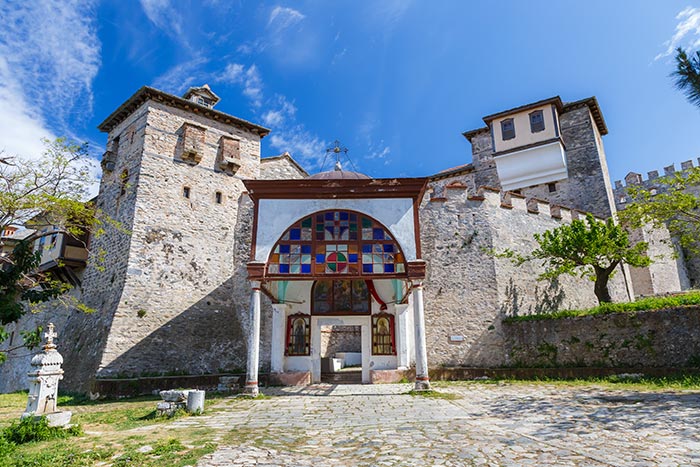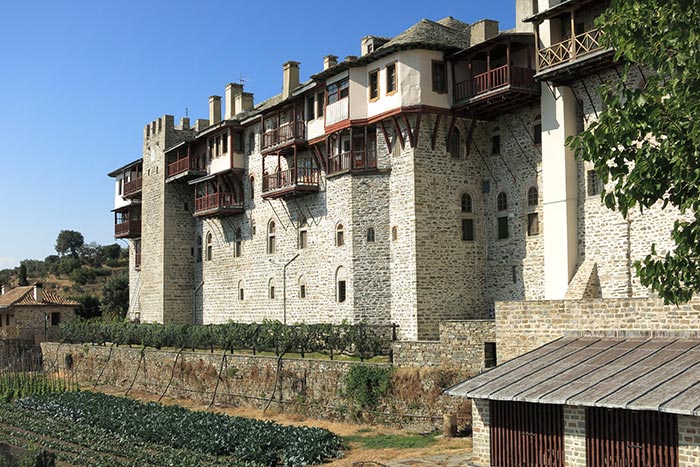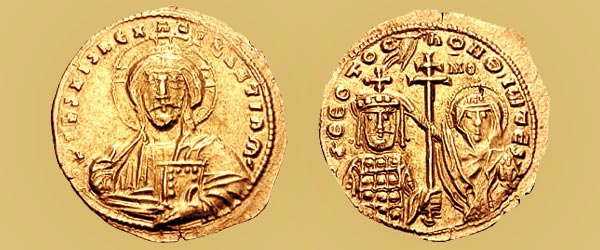
The History Of Mount Athos (4th century - 14th century)
In the 4th century AD, the first monks came to Mount Athos, disappointed of the boredom of everyday communal life, found this beautiful and uninhabited place ideal for worship the God. The chroniclers Theophanes the Confessor (end of 8th century) and Georgios Kedrenos (11th century) wrote that the 726 eruption of the Thera volcano was visible from Mount Athos, indicating that it was inhabited at the time.
The historian Genesios recorded that monks from Athos participated at the seventh Ecumenical Council of Nicaea of 787. Following the Battle of Thasos in 829, Athos was deserted for some time due to the destructive raids of the Cretan Saracens.

Around 860, the famous monk Efthymios the Younger came to Athos and a number of monks’ residences ("Skiti of Saint Basil") were created around his habitation, possibly near Krya Nera. During the reign of emperor Basil I the Macedonian, the former Archbishop of Crete (and later of Thessaloniki), Basil the Confessor built a small monastery at the place of the modern harbor of Helandarion Monastery.
Soon after this, an 883 AD document of states that a certain Ioannis Kolovos built a monastery at Megali Vigla. On a golden bull of Emperor Basil I, dated 885, the Holy Mountain is proclaimed a place of monks, and no laymen or farmers or cattle-breeders are allowed to be settled there.
The next year, in an imperial edict of Emperor Leo VI the Wise is written of the "so-called ancient seat of the council of gerondes (council of elders)", meaning that there was already a kind of monks' administration and that it was already "ancient". In 887, some monks expostulate to the emperor Leo the Wise that as the monastery of Kolovos is grows more and more, they are losing their peace.

In 908 the existence of a Protos (First monk), the "head" of the monastic community, is documented. In 943 the borders of the monastic state were precisely mapped; Karyes was already the capital and seat of the administration, named "Megali Mesi Lavra" (Big Central Assembly). In 956, a decree offered land of about 940,000 m2 (230 acres) to the Xiropotamos monastery, which means that this monastery was already quite big.
In 958, the monk Athanasios the Athonite (Άγιος Αθανάσιος ο Αθωνίτης) arrived on Mount Athos. In 962 he renovated the big central church of the "Protaton" in Karyes. In the next year, with the support of his friend Emperor Nicephorus Phocas, the monastery of Megisti Lavra was founded, still the largest and most prominent of the twenty monasteries existing today.
It enjoyed the protection of the Byzantine emperors during the following centuries, and its wealth and possessions grew considerably. In 972 Emperor John the First signed the famous “tragos” the first charter of Mount Athos, setting a state of coexistence of eremitic and coenobitic (community) systems. The population of the Holy Mount was growing as more and more monks were arriving and by the end of the 11th century most of the 20 monasteries existing today were founded as well as countless lavres and cells.

The end of The Fourth Crusade in the 13th century brought to Mount Athos new overlords (Roman Catholic barons), who did not miss their chance to benefit economically from every single monastery, which forced the monks to complain and ask for the intervention of Pope Innocent III.
The raids by the ruling the area barons haven’t stop until the restoration of the Byzantine Empire. The peninsula was raided by Catalan mercenaries in the 14th century, a century that also saw the theological conflict over the hesychasm practiced on Mount Athos and defended by Gregory Palamas (Άγιος Γρηγόριος ο Παλαμάς).
Read More
The history of Mount Athos: Antiquity & Mythology
The history of Mount Athos from the 15th century to the 18th century
The history of Mount Athos from the 19th century to the 20th century


